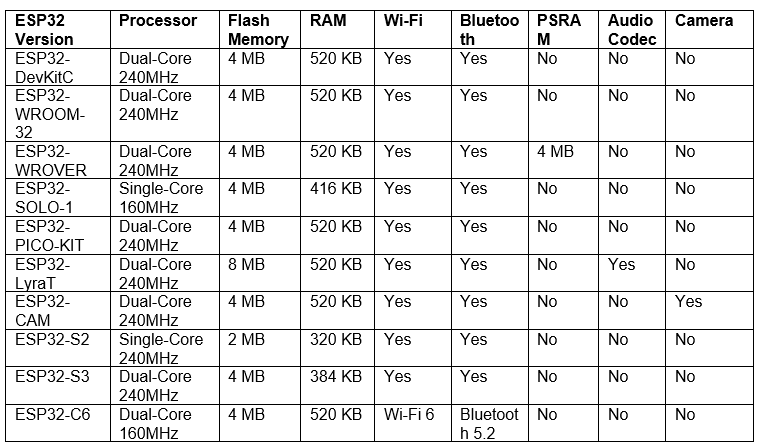The ESP32 microcontroller is a versatile and cost-effective solution for IoT projects. With built-in Wi-Fi, Bluetooth, and processing power, it offers a range of capabilities to suit a variety of needs. However, it can be difficult to identify the suitable ESP32 version for a project among the various options available. This article covers the different versions of the ESP32 and provides insight into their features.
Table of Contents
- ESP32-DevKitC
- ESP32-WROOM-32
- ESP32-WROVER
- ESP32-SOLO-1
- ESP32-PICO-KIT
- ESP32-LyraT
- ESP32-CAM
- ESP32-S2
- ESP32-S3
- ESP32-C6
- Comparison Table
- Conclusion
ESP32-DevKitC
ESP32-DevKitC is a low-footprint and entry-level development board that is part of the ESP32 series. This board has a rich peripheral set. The built-in ESP32 pinout is optimized for hassle-free prototyping.
The ESP32-DevKitC is a development board that features the ESP32-WROOM-32 module. This device is equipped with a 240 MHz dual-core processor, 4 MB of flash memory, and 520 KB of RAM. It comes with built-in Wi-Fi and Bluetooth functionalities but lacks an audio codec and a camera interface.
ESP32-WROOM-32
The ESP32-WROOM-32 is the most common version of the ESP32 microcontroller. This board is equipped with a 240 MHz dual-core processor, 4 MB of flash memory, and 520 KB of RAM. This version also includes built-in Wi-Fi and Bluetooth, making it a great choice for IoT projects.
ESP32-WROVER
The ESP32-WROVER is similar to the ESP32-WROOM-32 but with the addition of an extra 4 MB of PSRAM. This additional memory allows for more complex projects that require a higher level of processing power and memory.
ESP32-SOLO-1
The ESP32-SOLO-1 is a single-core version of the ESP32, with a clock speed of up to 160MHz. It comes with 4 MB flash memory, 416 KB SRAM, and integrated Wi-Fi and Bluetooth capabilities. This version is ideal for projects that require lower power consumption and are not as complex as those requiring a dual-core processor.
ESP32-PICO-KIT
The ESP32-PICO-KIT is a development board that includes the ESP32-PICO module. The module has a 240MHz dual-core processor, 4 MB flash memory, and 520 KB SRAM. This version is ideal for hobbyists and professionals who want a portable, easy-to-use microcontroller.
ESP32-PICO-KIT is Espressif’s smallest development board, as it fits into a mini breadboard. It is fully functional with the minimum number of discrete components, while it has all the ESP32 pins exposed.
ESP32-LyraT
The ESP32-LyraT is a development board that has been specifically created for audio-based applications. Its features include a dual-core processor, 8 MB flash memory, and 520 kB of SRAM. It has its inbuilt audio codec and microphone, making it a preferred choice for music and voice-related projects.
The ESP32-LyraT development board targets the speech and voice recognition market, and it incorporates the ESP32-WROVER-E module. This module comes equipped with a dual-core processor and 4.5 MB of operating memory. The board’s unique features allow for the creation of highly integrated audio solutions with a minimal need for external peripheral devices.
ESP32-CAM
The ESP32-CAM is a development board designed for camera applications. It is equipped with a dual-core processor, 4 MB flash memory, and 520 KB SRAM. Additionally, it includes a built-in OV2640 camera module, making it an excellent choice for camera projects.
ESP32-S2
The ESP32-S2 is a newer version of the ESP32 that is designed for low-power IoT applications. It features a single-core processor with a clock speed of up to 240MHz, 2.4GHz Wi-Fi, and built-in security features.
ESP32-S2-DevKitM-1 is an entry-level development board based on the ESP32-S2-MINI series. It has all the ESP32-S2 pins exposed and is easy to connect and use.
ESP32-S3
ESP32-S3 general-purpose development board, based on ESP32-S3-WROOM-1/1U or ESP32-S3-WROOM-2/2U. It has all the ESP32-S3 pins exposed and is easy to connect and use.
The ESP32-S3 has a clock speed of up to 240MHz and built-in security features. It has a dual-core processor, along with 4 MB of flash memory and 384 KB of SRAM. This version is designed for applications that require a higher level of security, such as smart homes and industrial automation.
ESP32-C6
The ESP32-C6 is a Wi-Fi 6 and Bluetooth 5.2 enabled microcontroller. It contains a dual-core processor with a clock up to 160MHz. It also has 4 MB of flash memory, and 520 KB of SRAM. This version is ideal for applications that require high-speed wireless communication and low power consumption.
ESP32-C6 general-purpose development board, based on ESP32-C6-WROOM-1. It has all the ESP32-C6 pins exposed and is easy to connect and use. Most of the I/O pins are broken out to the pin headers on both sides for easy interfacing. Developers can either connect peripherals with jumper wires or mount ESP32-C6-DevKitC-1 on a breadboard.
Comparison Table
To choose the right ESP32 version for the project, the following is the comparison table that highlights the key features of each version.
Conclusion
The ESP32 is a versatile microcontroller with a range of versions available to suit a variety of project needs. Each ESP32 version is designed for different applications. While choosing the ESP32 board remember to check the factors such as processing power, memory, connectivity, and additional features such as audio and camera capabilities. This article covers all detailed description and comparison of some of the popular ESP32 boards. To know more about ESP32 board versions, click here.

